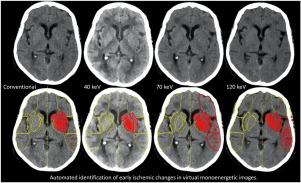Journal of Neuroradiology ( IF 3.5 ) Pub Date : 2020-12-17 , DOI: 10.1016/j.neurad.2020.12.002 Fredrik Ståhl 1 , Vamsi Gontu 1 , Håkan Almqvist 1 , Michael V Mazya 2 , Anna Falk Delgado 1

|
Background and purpose
Dual energy CT is increasingly available and used in the standard diagnostic setting of ischemic stroke patients. We aimed to evaluate how different dual energy CT virtual monoenergetic energy levels impact identification of early ischemic changes, compared to conventional polyenergetic CT images.
Materials and methods
This retrospective single-center study included patients presenting with acute ischemic stroke caused by an occlusion of the intracranial internal carotid artery or proximal middle cerebral artery. Data was gathered on consecutive patients admitted to our institution who underwent initial diagnostic stroke imaging with dual layer dual energy CT and a subsequent follow-up CT one to three days after admission. Automated ASPECTS results from conventional polyenergetic and different virtual monoenergetic energy level reconstructions at admission were generated and compared to reference standard ASPECTS. Confidence intervals (CI) for sensitivity, specificity, negative and positive predictive value were calculated.
Results
A total of 24 patients were included. Virtual monoenergetic reconstructions of 70 keV had the highest region-based ASPECTS accuracy, 0.90 (sensitivity 0.82 (95% CI 0.72–0.93), specificity 0.92 (0.88–0.97), negative predictive value 0.94 (0.90–0.96)), whereas virtual monoenergetic reconstructions of 40 keV had the lowest, 0.77 (sensitivity 0.34 (0.26–0.42), specificity 0.90 (0.89–0.96), negative predictive value 0.80 (0.77–0.83)).
Conclusions
Automated 70 keV ASPECTS had the highest diagnostic accuracy, sensitivity and negative predictive value overall. Our results indicate that virtual monoenergetic energy levels impact the identification of early ischemic changes on CT.
中文翻译:

双层双能CT虚拟单能图像识别前循环大血管闭塞患者早期缺血变化的性能
背景和目的
双能 CT 越来越多地用于缺血性中风患者的标准诊断环境中。我们旨在评估与传统多能 CT 图像相比,不同的双能 CT 虚拟单能能级如何影响早期缺血变化的识别。
材料和方法
这项回顾性单中心研究包括因颅内颈内动脉或大脑中动脉近端闭塞而出现急性缺血性卒中的患者。我们收集了连续入院的患者的数据,这些患者接受了双层双能 CT 的初步诊断性卒中成像,并在入院后 1 到 3 天进行了后续随访。自动生成来自入院时传统多能和不同虚拟单能能级重建的 ASPECTS 结果,并与参考标准 ASPECTS 进行比较。计算敏感性、特异性、阴性和阳性预测值的置信区间(CI)。
结果
共纳入 24 名患者。70 keV 的虚拟单能重建具有最高的基于区域的 ASPECTS 准确度,0.90(灵敏度 0.82(95% CI 0.72-0.93),特异性 0.92(0.88-0.97),阴性预测值 0.94(0.90-0.96),而虚拟单能), 40 keV 的重建最低,为 0.77(敏感性 0.34 (0.26-0.42),特异性 0.90 (0.89-0.96),阴性预测值 0.80 (0.77-0.83))。
结论
自动化的 70 keV ASPECTS 总体上具有最高的诊断准确度、灵敏度和阴性预测值。我们的结果表明虚拟单能能级影响 CT 上早期缺血变化的识别。


























 京公网安备 11010802027423号
京公网安备 11010802027423号